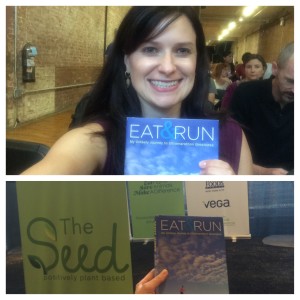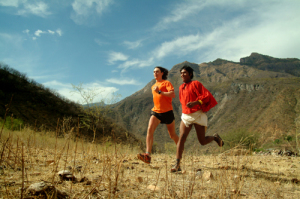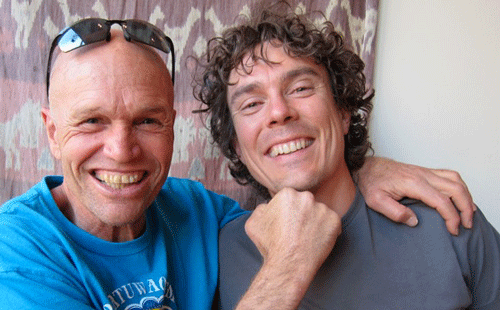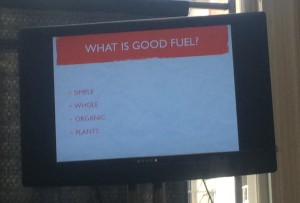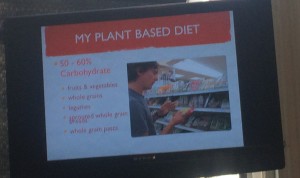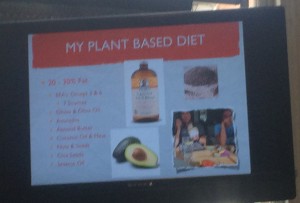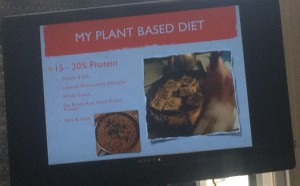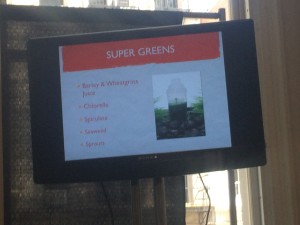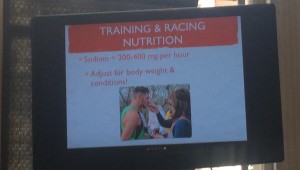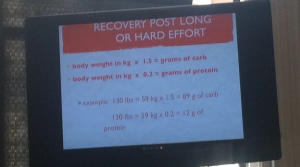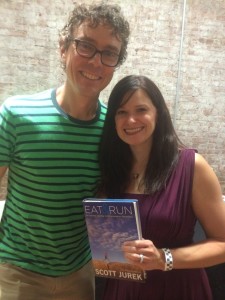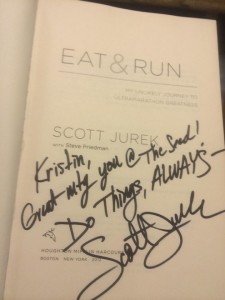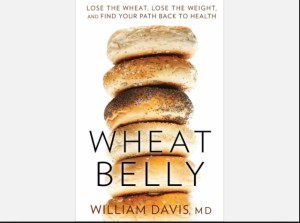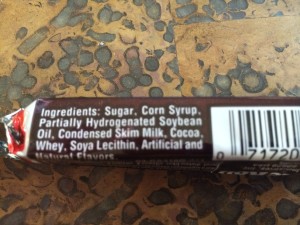In a previous post titled “Selfies with Scott Jurek & Matt Frazier at The Seed!,” I talked about what it was like to attend The Seed Experience in New York City on August 9, 2014. Thanks to Matt Frazier of No Meat Athlete, I found out about this amazing and educational plant-based expo! There were not only many vendors sampling vegan foods and items, but also well known vegan advocates doing presentations! Once I saw that ultra marathoner Scott Jurek was on the schedule – I knew I HAD to go!!
In this post, I wanted to break down Scott’s presentation in which he shared anecdotal stories, the benefits of a plant-based diet, what his diet consists of, and race nutrition.
First we’ll start with the selfie that I took with his book, Eat & Run, as I eagerly awaited the presentation. 🙂
Scott started the presentation by talking about races he had participated in, such as the Western States 100-Mile Endurance Run and the Badwater Ultra marathon. The Western States 100 is the world’s oldest and most prestigious 100-mile trail race. It starts in Squaw Valley, California and ends 100.2 miles later in Auburn, California. Runners climb more than 18,000 feet and descend nearly 23,000 feet before they reach the finish line at Placer High School in Auburn. In 2004, he not only set a course record of 15:36:27, but he finished the course in the daytime which was a huge goal for him!
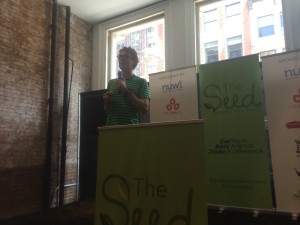
By the way, the temperature during this race can reach 105 degrees! The picture below shows Scott at mile 78 – the best spot on the course! Photo courtesy of Scott’s website.
Scott also brought up the mostly plant-based diet of the Tarahumara Indians and how we could all benefit from fueling our bodies this way. For those not familiar, Scott was featured in Born to Run: A Hidden Tribe, Superathletes, and the Greatest Race the World Has Never Seen, or better known as Born to Run, a 2009 best-selling book written by Christopher McDougall. Scott was one of the elite runners who was recruited by Micah True, aka Caballo Blanco, (White Horse) to run with the Tarahumara Indians in the Mexican Copper Canyons. Photo courtesy of Scott’s website.
Pictured below you can see Micah True (left) and Scott (right). (Photo courtesy of Runner’s World). In the article, “The Deer Remembers the White Horse,” published on Runner’s World website, Scott reflects on his friendship with Micah who has since passed.
For more information about Born to Run and Micah True, check out this link about a movie that will be coming out called Run Free – The True Story of Caballo Blanco.
Scott then transitioned into the topic of how food can be good fuel.
Scott realized that fueling his body properly would help avoid injuries and prevent disease. He mentioned two books that help inspired him to improve his diet – Mad Cowboy: Plain Truth from the Cattle Rancher Who Won’t Eat Meat by Howard F. Lyman and Spontaneous Healing by Dr. Andrew Weil, MD.
Scott used the analogy of putting fuel into a race car and how that applies to the fuel that we put into our own bodies. Sure, you can put whatever kind of fuel in a race car and it will go around the track a few times, but will it be better for the engine long term? Just like the race car, we know that we can survive and even run for a while with unhealthy food, even unhealthy vegan food (think Mountain Dew and Twinkies), but how will it affect our health long term? This is where Scott wants to encourage us to put the best, highest octane fuel into our bodies (and this applies to all forms of food, not just plant-based).
Scott describes the benefits he’s seen from adopting a plant-based diet:
- As an athlete, he realizes that he needs to take responsibility for his own health. We can’t just rely on doctors and technology alone.
- Longevity is key for his health and his athletic performance. He’s hoping to prevent diseases like diabetes and he’s not looking for quick fixes that will make him perform better. In the long term, how is our diet affecting our heart health and cholesterol, and preventing diseases such as diabetes?
- There is a great deal of satisfaction when you know what kind of foods you are putting into your body and being in control. It also serves as a performance edge when you are standing on that starting line knowing that everyone has trained similarly but knowing that YOU have an edge when it comes to how you fueled your body along the way.
Scott then made a joke, he said “Do we have any Paleo folks in the audience by the way? Did they let them in?” LOL. One thing that I really appreciated about that, is that he made a point of acknowledging that many types of diets bring their own benefits and that people of all diets should really get along! The ones that tend to be successful, however, are the ones that include a high amount of plant-based foods (i.e. fruit, veggies, whole grains, and legumes).
Next, he talked about how he used natural remedies to help heal an injury before a race including turmeric, bromelain, garlic, ginger, Vitamin C, ice, and compression. Our bodies go through cycles of inflammation and even though drugs can help diminish the pain, they can prolong that cycle. Plants have a lot of power and healing attributes in them and it’s important to see plants as medicine.
Scott gave tips for adopting a plant-based diet:
- Integration: Instead of thinking about the foods he can’t eat, he thinks about what he can incorporate and use to replace old, unhealthy foods.
- Quantity: If you are an athlete on a vegan diet and you don’t feel that you have enough energy, then you are probably not getting enough calories.
- Quality: Once you have figured out if you are eating enough, then you can focus on quality and all of the nutritious foods to eat on a plant-based diet like quinoa and goji berries.
Next, Scott went into the “Scott Jurek Secrets” otherwise known as his own plant-based diet!

What does Scott’s plant-based diet look like:
- 80-90% Whole Foods
- 90% Organic. It’s important to purchase organic fruits and vegetables to avoid pesticides. Follow the guidelines of the Clean Fifteen and the Dirty Dozen fruits and vegetables from the EWG (Environmental Working Group).
- Local Farmer’s Market, garden, homemade meals
- 50-60% Carbohydrates (fruits, veggies, whole grains, legumes, sprouted whole grain breads, whole grain pasta)
- 20-30% Fat (Omega 3 & 6, olives, olive oil, avocados, almond butter, coconut oil & meat, nuts, seeds, chia seeds, sesame oil)
- 15-20% Protein (tempeh, tofu, beans, edamame, whole grains, nuts, seeds, and protein powders such as pea, brown rice, and hemp)
- Scott emphasizes getting your nutrient needs from food first, however, B12, Zinc, Magnesium, Calcium, and Iron are examples of micronutrients that those on a plant-based diet may be deficient in. Monitor these levels and decide whether you need to supplement.
- Super Greens to incorporate into your diet include: barley, wheatgrass, chlorella, spirulina, seaweed and sprouts.
Scott also went into Training and Racing Nutrition:
- Sodium = 200-400 mg per hour (this can vary depending on your individual weight)
- Carbohydrate formulas:
- Body weight in kg x 0.7 = grams of carbs to consume per hour (min)
- Body weight in kg x 1.0 = grams of carbs to consume per hour (max)
When you are engaging in exercise that lasts longer than 90 minutes or 2 hours, you will need to replace glucose (carbohydrate) because you will burn through your glycogen storage at that point. Focusing on carbohydrates during training is important because that’s how the body will keep your endurance levels up.
Next, Scott got up close and personal with the audience during the Q & A!
Here are some Q & A highlights:
- Food during training: As an ultra runner, running long distances day in and day out, it’s important to consume actual real food including bananas, potatoes, and bean and rice burritos. **(Side note: for more healthy and easy to make recipes to fuel your runs, please see my friend Zucchini Runner‘s guest post on MichRun4‘s site which talks about all Clean Running Fuel.)
- Raw plant-based foods vs. cooked: Scott personally consumes about 30-40% raw foods (especially desserts!). He says being a professional athlete on a raw diet can be done, but suggested that you do what’s best for you and that more importantly, you make sure that you are getting enough calories to keep your energy levels up.
- Post-exercise recovery: For workouts longer than 90 minutes, use this formula:
- Body weight in kg x 1.5 = grams of carbs
- Body weight in kg x 0.2 = grams of proteins
He talked about how important it is to consume carbs during a workout, and emphasized how important protein’s role is after a workout. Protein will help build the glycogen stores back into the muscles. There is also a time window of 20-30 minutes post-exercise that you should be following these formulas. Also take note that these formulas are based on weight. A 120 pound female will not be consuming the same as a 195 pound male for instance.
After the presentation I got in line to get my book signed!
We even took a selfie!
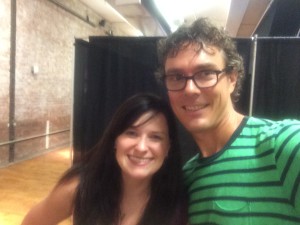
All in all, meeting Scott was truly a bucket list moment! It was fascinating to not only meet him in person, but to actually hear about nutrition from his point of view and his experiences as an ultra marathoner! In the end, runners of ALL DISTANCES can apply his nutritional principles! It doesn’t matter whether you run ultras, marathons, or 5k races – EVERYONE can benefit from consuming whole, real, organic sources of fuel before, after, and during a run!
So how do you think YOU’LL be fueling your next run?! I know that I’ll be making some changes myself!
Also, if you’d like to hear videos that I took during Scott’s presentation, please visit my Facebook page, Cook and Run with Kristin.

